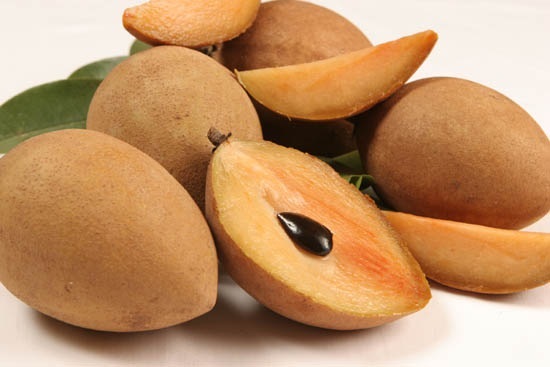Main Name: Sapodilla
Biological Name: Manilkara zapota
Names in Other Languages: Manikara zapota (Spanish), Sapotillier (French), Chikoo, Chiku (Hindi), Sapota (Malayalam, Tamil, Telugu), Chiku (Gujarati), Sopeta, Sofeda (Bengali), Chikku (Marathi), Sapeta (Oriya), Cheeku (Urdu)
Biological Name: Manilkara zapota
Names in Other Languages: Manikara zapota (Spanish), Sapotillier (French), Chikoo, Chiku (Hindi), Sapota (Malayalam, Tamil, Telugu), Chiku (Gujarati), Sopeta, Sofeda (Bengali), Chikku (Marathi), Sapeta (Oriya), Cheeku (Urdu)
Have you seen seasonal brown ellipsoidal fruits on display in vegetable markets and stores? These potato-like fruits are actually sapodilla, also known as ‘chikoo’ in India. The tropical evergreen fruit, sapodilla, belongs to the Sapotaceae family and is botanically known as Manilkara zapota. While the trees of this fruit can grow up to heights of 30 meters, the large ellipsoid berries are about 4-8cm in diameter. The sapodilla has an exceptionally sweet and malty flavour, resembling a combination of peaches, pears, brown sugar, cinnamon and a little brandy. The soft and creamy flesh of the fruit is made up of simple sugars that replenish energy and revitalize the body instantly. While the fruit is great to eat, it can be blended into a delicious dessert sauce or mousse. Not only does sapodilla have a smooth textured and sweet tasting pulp, it also has a myriad of health benefits. Look through the different nutritious advantages that sapodilla possesses, as you browse through the following sections.
History
Sapodilla is believed to have originated in the Central American rain forests, probably in Mexico and Belize. It has now spread across the tropical belt and is being commercially grown in a large scale in India, Sri Lanka, Indonesia and Malaysia. Sapodilla grows naturally in coastal Yucatan in the Petenes mangroves eco-region, where it is a subdominant plant species. This plant was introduced to the Philippines during the Spanish colonization. The sapodilla tree grows fast and is resistant to the wind and drought hence making it suitable to withstand dry arid regions with scanty rains. However, in order to get a good fruit yield, irrigation is necessary during the summer season.
Sapodilla is believed to have originated in the Central American rain forests, probably in Mexico and Belize. It has now spread across the tropical belt and is being commercially grown in a large scale in India, Sri Lanka, Indonesia and Malaysia. Sapodilla grows naturally in coastal Yucatan in the Petenes mangroves eco-region, where it is a subdominant plant species. This plant was introduced to the Philippines during the Spanish colonization. The sapodilla tree grows fast and is resistant to the wind and drought hence making it suitable to withstand dry arid regions with scanty rains. However, in order to get a good fruit yield, irrigation is necessary during the summer season.

Health Benefits of Sapodilla
- Sapodilla is a good source of dietary fiber, which makes it a bulk laxative. The fiber content in the fruit provides relief in case of constipation and also helps in protecting the mucous membrane of the colon from cancer causing toxins by firmly binding to them.
- These fruits are very rich in the antioxidant polyphenolic compound called tannin. Tannins are naturally occurring organic substances that neutralize acids by precipitating proteins. Studies prove that tannins have potential anti-inflammatory, antiviral, anti-bacterial and anti-parasitic effects, thus, making sapodilla beneficial in several medicinal applications.
- Sapodilla helps in limiting conditions such as erosive gastritis, reflux-esophagitis, enteritis and irritating bowel disorders.
- Owing to a good amount of antioxidant vitamins such as A and C, sapodilla can be consumed on a daily basis. Vitamin A is essential for vision, helps in maintaining a healthy mucus membrane and prevents lung and oral cavity cancers. Vitamin C, on the other hand, helps the body in developing resistance against infectious agents and other harmful free radicals.
- Sapodilla is a good source of minerals like potassium, copper, iron and vitamins such as folate, niacin and pantothenic acid. These compounds play a pivotal role in maintaining optimum health due to their involvement in various metabolic processes in the body, as cofactors for the enzymes.
- Eating few pieces of the fruit provides you with an instantaneous boost of energy as it contains the simple sugars, fructose and sucrose.
- Sapodilla is helpful during pregnancy as it prevents cases of morning sickness. It boosts the function of electrolytes in the nervous system.
- This fruit helps in promoting collagen production, thereby contributing towards rejuvenation of skin. Ingredients in sapodilla slow down the ageing process and delay the formation of wrinkles.
- The juice extracted from the seeds of this fruit is an effective sedative and can be used in treating anxiety and depression. It is also a diuretic and aids in removing stones from internal organs.
Sapodilla Nutrition FactsAmount: 1
Weight: 170 g
Weight: 170 g
| Nutrients | Amount |
| Basic Components | |
| Proteins | 748 mg |
| Water | 133 g |
| Ash | 0.8 g |
| – | – |
| Calories | – |
| Total Calories | 141 |
| Calories From Carbohydrates | 122 |
| Calories From Fats | 16 |
| Calories From Proteins | 2.5 |
| – | – |
| Carbohydrates | – |
| Total Carbohydrates | 34 g |
| Dietary Fiber | 9 g |
| – | – |
| Fats & Fatty Acids | – |
| Total Fat | 1.9 g |
| Saturated Fat | 330 mg |
| Monounsaturated Fat | 886 mg |
| Polyunsaturated Fat | 19 mg |
| Omega-6 Fatty Acids | 19 mg |
| – | – |
| Vitamins | – |
| Vitamin A | 102 IU |
| Vitamin C | 25 mg |
| Riboflavin | 34 mcg |
| Niacin | 340 mcg |
| Vitamin B6 | 63 mcg |
| Folate | 24 mcg |
| Pantothenic Acid | 428 mcg |
| – | – |
| Minerals | – |
| Calcium | 36 mg |
| Iron | 1.4 mg |
| Magnesium | 20 mg |
| Phosphorus | 20 mg |
| Potassium | 328 mg |
| Sodium | 20 mg |
| Zinc | 170 mg |
| Copper | 146 mcg |
| Selenium | 1 mcg |
 http://mypellau.com/pellaumag/naseberry-mamey-nispero-sapodilla/
http://mypellau.com/pellaumag/naseberry-mamey-nispero-sapodilla/
How many calories in sapodilla (per 100 gm)
Sapodilla has about 83 calories per 100 gm of weight.
Sapodilla has about 83 calories per 100 gm of weight.
How to Buy Sapodilla
- Sapodillas are easily available in the market, all year round. Harvesting is generally done by gently plucking each fruit out. A matured fruit appears brown and will easily separate from the stem without the leaking of latex.
- Check if the skin is green beneath the surface by scratching a portion of the fruit.
- Always buy fresh sapodilla where the skin is smooth and intact skin and free from cuts, cracks, bruises or wrinkles. Ripened fruits need to be preserved carefully during storage.
Sapodilla Storage Tips
- Mature, but unripe fruits, must be stored at room temperature for 7 to 10 days to ripen.
- If stored in a refrigerator, ripe sapodillas can be kept for a longer period of time, about 6 weeks, at 35 °F.

